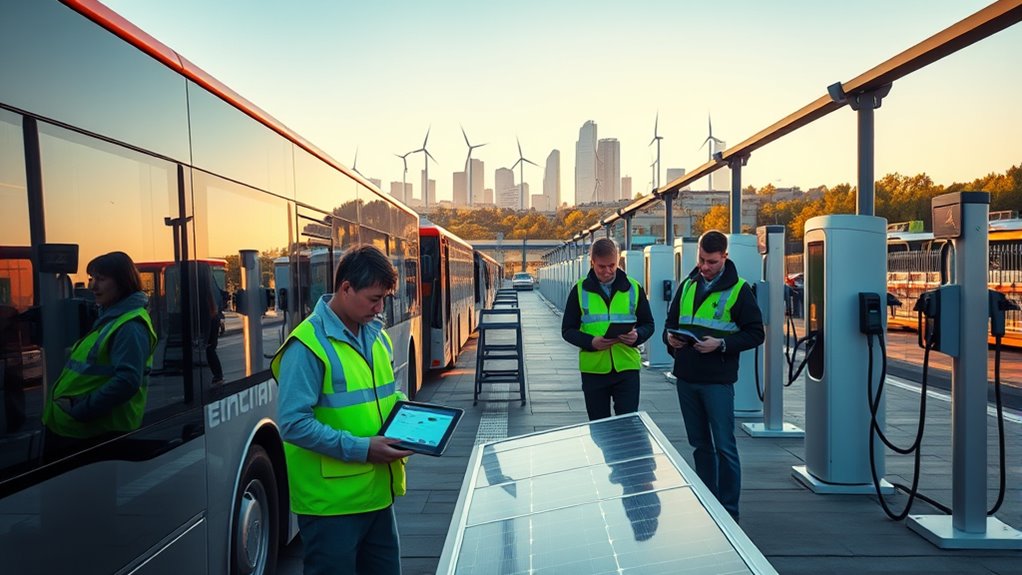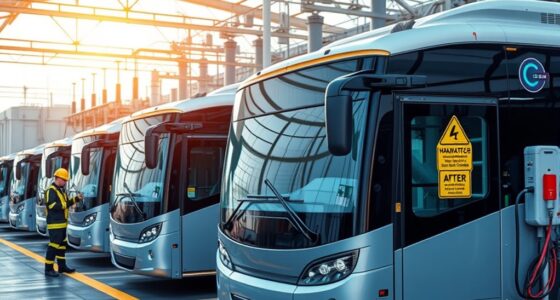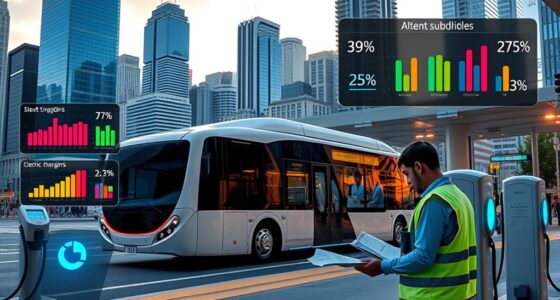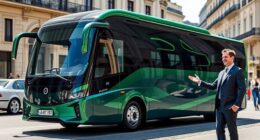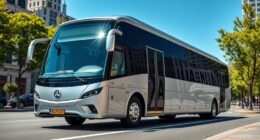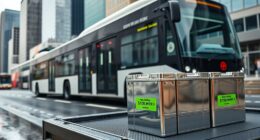Local authorities can support electric bus adoption by offering financial incentives and subsidies that lower upfront costs, making buses more affordable. Collaborating with utility companies to develop charging infrastructure and establishing public-private partnerships can guarantee a reliable network. Engaging stakeholders through education and community outreach builds support and awareness. Implementing supportive policies and safety measures creates a conducive environment. To discover more ways to foster this progression, explore further insights on effective strategies and best practices.
Key Takeaways
- Offer financial incentives and subsidies to reduce upfront costs for electric buses and charging infrastructure.
- Collaborate with utility companies and develop public-private partnerships for efficient charging networks.
- Engage community stakeholders through education campaigns, workshops, and public events to build support.
- Develop comprehensive financial plans using grants, loans, and long-term maintenance strategies to ensure sustainability.
- Establish supportive policies, regulations, and safety measures that encourage electric bus adoption and infrastructure security.
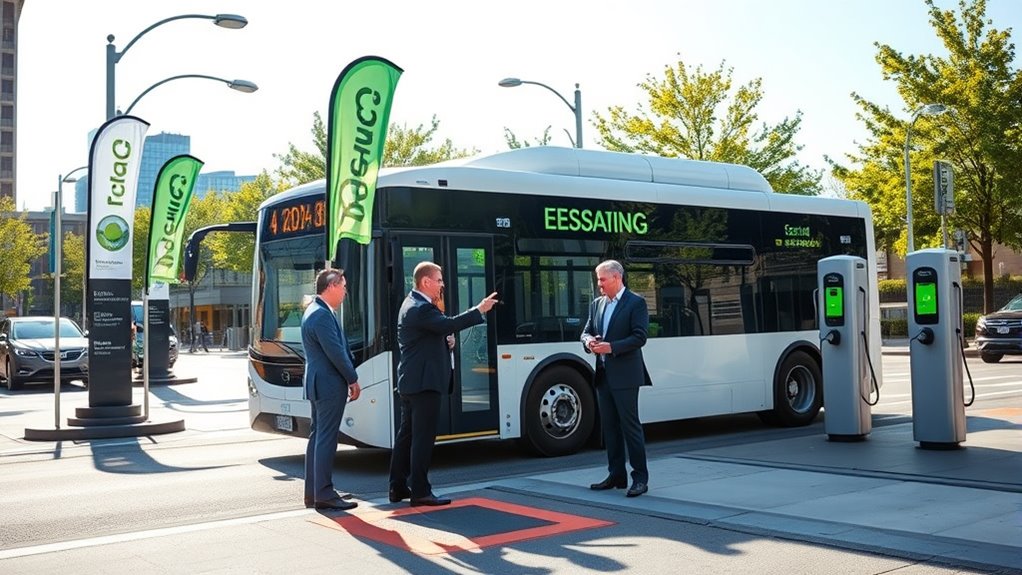
Support for electric buses has gained momentum as governments and communities recognize their environmental and economic benefits. As someone involved in transportation planning, you can leverage government incentives and subsidies to make the switch more affordable. Many programs cover a large part of the purchase price, significantly reducing upfront costs and making electric buses competitive with traditional diesel options. These incentives aren’t limited to vehicle purchases alone; they often include support for infrastructure investments like charging stations, which are essential for smooth operation.
Leverage government incentives to lower costs and support infrastructure for electric bus adoption.
By tapping into these programs, you can create a thorough plan that not only acquires buses but also builds the necessary infrastructure, encouraging wider adoption. The presence of financial support has already driven demand, demonstrating that policy effectiveness can accelerate the transition to cleaner transportation. Financial incentives can also motivate local stakeholders to prioritize electric bus projects, further enhancing adoption rates.
Building a robust charging infrastructure is essential. You should collaborate with utility companies to design efficient charging networks that can handle the increased electricity demand. Engaging in public-private partnerships can help finance and develop the necessary infrastructure, reducing the financial burden on local governments. Additionally, exploring innovative solutions like smart charging can optimize energy use and reduce costs. Incorporating cost-effective infrastructure planning ensures long-term sustainability and scalability of the electric bus fleet.
Investing in grid capacity is also fundamental to ensure the electricity supply can support a growing fleet of electric buses without causing outages or instability. When infrastructure is in place, operational efficiency improves, and electric buses become a viable, long-term solution for daily transit needs.
Community and stakeholder engagement plays a pivotal role in successful electric bus adoption. Educating residents and local businesses about the environmental benefits and economic advantages can foster support. Conducting stakeholder analysis helps identify key players, including residents, transit workers, and businesses, whose input can shape effective implementation strategies.
Hosting public events, webinars, and workshops raises awareness, dispels misconceptions, and builds enthusiasm for the transition. Establishing partnerships with organizations, community groups, and other agencies can provide additional resources, expertise, and support. When stakeholders are involved early and actively, projects tend to run more smoothly and gain broader acceptance.
Financial planning is essential for sustaining your electric bus fleet. Combining grants, subsidies, and loans can help cover costs and reduce financial risks. Exploring diverse financing options, like public-private partnerships, enables you to manage expenses more effectively. Moreover, long-term maintenance planning ensures the fleet remains operational and cost-efficient over its lifespan.
Federal and local grant programs can greatly cut costs, making electric buses more accessible. Conducting detailed cost-benefit analyses ensures you understand long-term savings from lower fuel and maintenance costs, justifying initial investments. Developing sustainable budgets guarantees ongoing support for operations, maintenance, and future expansion, ensuring the initiative remains viable over time.
Additionally, considering the cost of home security systems can help protect new infrastructure investments and ensure safety for staff and equipment. Establishing strong policy frameworks supports your efforts. Enacting supportive regulations and emissions standards encourages the adoption of electric buses. Designing incentives that reward clean transportation can motivate stakeholders to participate.
Frequently Asked Questions
How Do Local Authorities Finance Electric Bus Programs?
You can finance electric bus programs through various methods. Tap into federal grants and combine them with state and local funds to maximize resources.
Consider private financing options like green banks or public-private partnerships to reduce upfront costs. Issuing municipal bonds can also raise capital, while funding infrastructure development, such as charging stations, guarantees successful adoption.
Strategic planning, community engagement, and phased implementation help manage costs and ensure long-term success.
What Are the Best Locations for Charging Stations?
You should prioritize placing charging stations in urban areas with high bus demand, near bus depots for efficiency, and along busy routes for quick turnaround.
Make sure they’re integrated into existing transportation hubs or parking lots, and account for local weather and grid capacity.
Fast-charging technology and real-time monitoring improve efficiency, while accessible, safe locations encourage usage.
Strategic placement maximizes charging availability and supports smooth electric bus operations.
How Can Communities Encourage Public Acceptance of Electric Buses?
Imagine children pointing excitedly at electric buses gliding silently through your streets. You can encourage public acceptance by launching awareness campaigns that highlight environmental and health benefits, making electric buses a source of community pride.
Organize community events, involve local schools, and share success stories through media. When people see electric buses as part of their daily lives, their support naturally grows, making the changeover smoother and more embraced.
What Maintenance Training Is Needed for Electric Bus Fleets?
You need thorough maintenance training to keep electric bus fleets running smoothly. This includes learning high-voltage safety protocols, diagnostic software use, and charging infrastructure upkeep.
You should also understand regenerative braking systems, battery lifecycle management, and emergency response procedures.
Regular recertification is essential to stay current with technological updates.
Are There Any Legal or Regulatory Hurdles to Electric Bus Deployment?
You might worry about legal hurdles, but with proper planning, they’re manageable. Regulatory challenges include ensuring compliance with accessibility standards, land acquisition for charging stations, and steering through complex policies.
To overcome these, develop clear guidelines, engage stakeholders early, and leverage financial incentives. Regular audits and collaboration help maintain compliance, making the deployment smoother.
Addressing these hurdles proactively ensures your electric bus project stays on track and meets all legal requirements.
Conclusion
By actively supporting electric bus adoption, you’re planting seeds for a cleaner future. Think of each bus as a sapling that grows stronger with your care. When you invest in charging infrastructure or prioritize green policies, you’re nurturing a forest of sustainable transportation. Just like a single tree can transform a landscape, your efforts can reshape your community’s air quality and quality of life. Together, you can help the city breathe easier and thrive.
